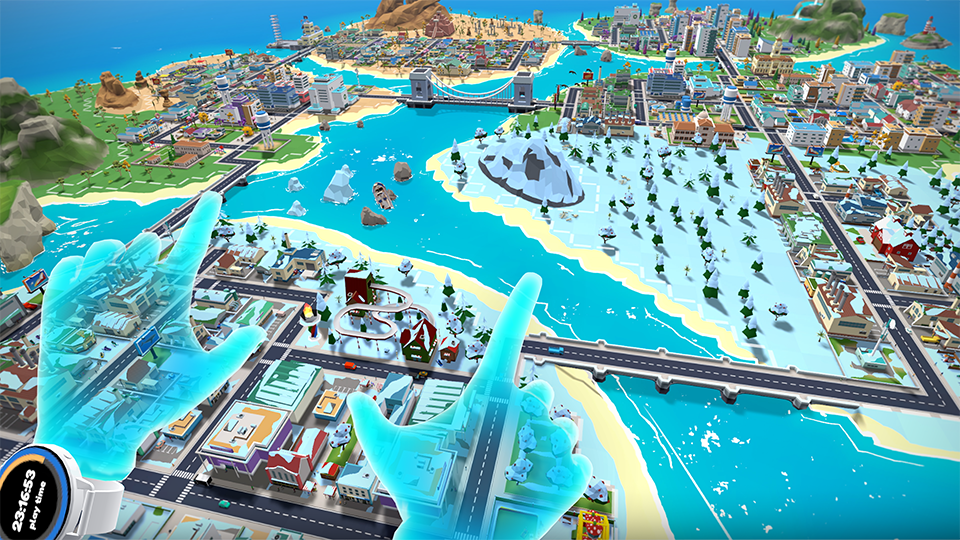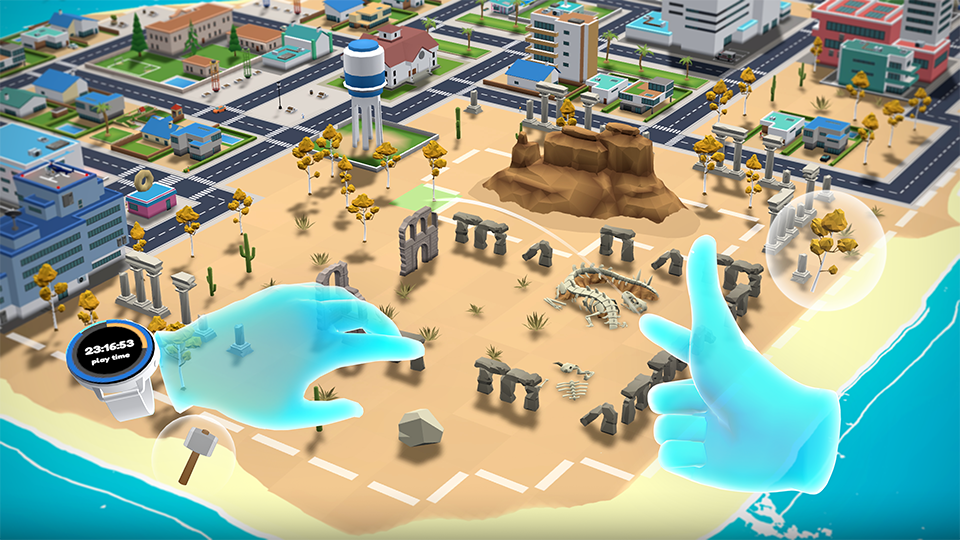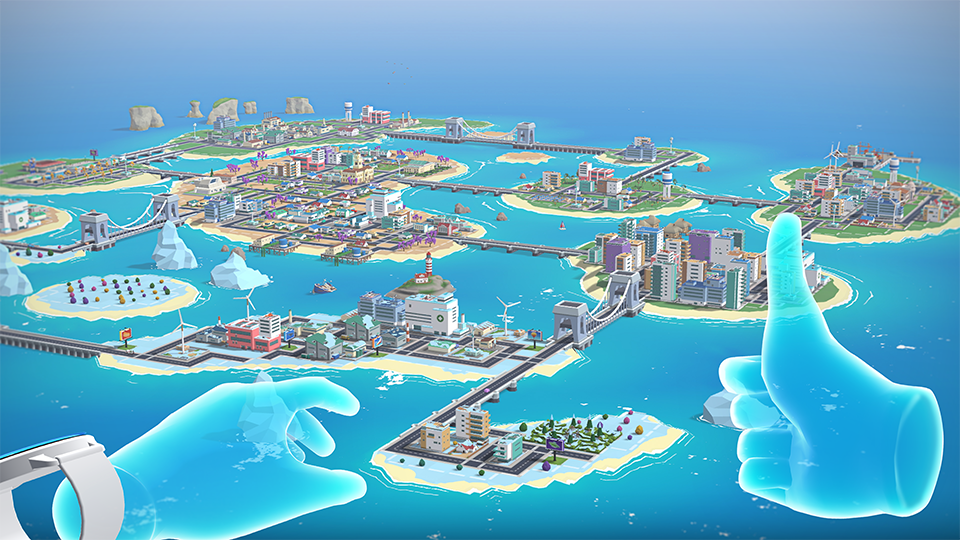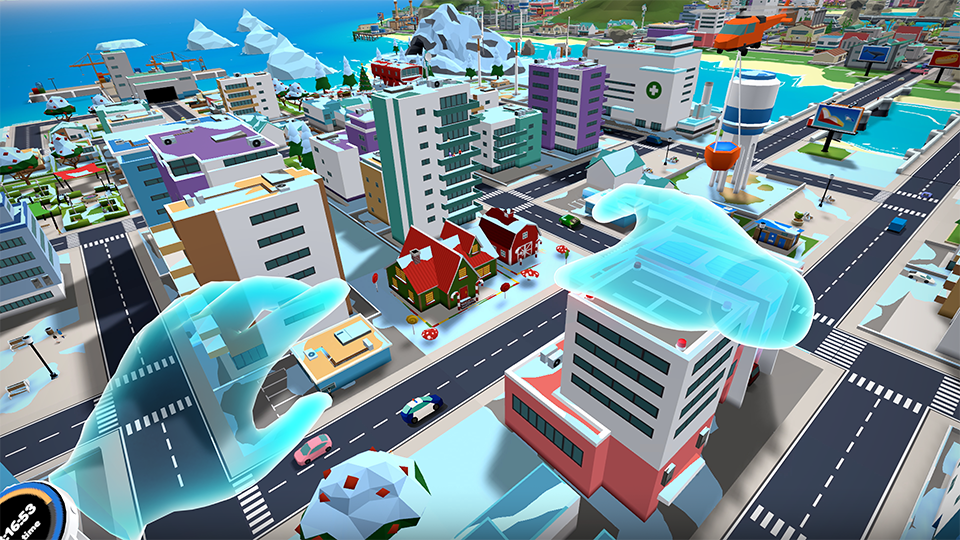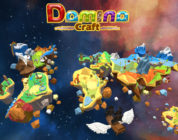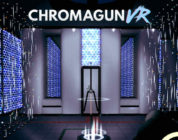Developer / Publisher – Purple Yonder / nDreams
Price – US $24.99 / CAN $34.99 / EU €24.99 / UK £24.99
Release Date – March 12th, 2024
Input – 2 x Tracked Motion Controllers
Play Area – Seated, Standing, Roomscale
Store – PlayStation
Reviewed on – PSVR 2
I had the opportunity to review Little Cities back when it 1st launched on the Quest platform and enjoyed it’s more casual take on the genre as it felt like a much less stressful Sim City though admittedly found the game to be easy to a point of boredom. Well fast forward 2 years and we get the Bigger Edition which includes (almost) all of the DLC and add-ons that have come out since release.
I’ll get the “new” stuff out of the way as not too much has changed since my initial review other then the fact that there is largely just “more” of everything. Now in the game are people that you can see chilling and walking around your cities which is a huge addition as their absence was noticed in a game where building up the population is the largest goal. The “Attractions” DLC offers up new cosmetics for your cities that adds totally optional style points to chase if your so inclined with the bonus of having some of these attractions work in conjunction with specific building for extra points and even some secret unlockables. Sandbox is self explanatory and lets you create a level from scratch from landmasses, obstacles and everything else which is a great way to increase the challenge that the main game lacks or just chill and make something to your own liking. Lastly is Snow Islands DLC which includes 2 winter themed islands that offer up new buildings and attractions as well as destructive avalanches that can take out sections of your town. I’m happy with all of this added content as it does expand upon the core game and just offers up more to do and contend with and makes this “Bigger” version feel like a more complete package. One note would be that the hand tracking update is not available for the PSVR 2 version, though I will say that, after revisiting the game on the Quest 3, I was impressed by just how well that worked and is one of the better uses for that tech.
You’ll start off on the 1st of 8 islands that brings you through a quick tutorial highlighting the controls and movement options before leaving you to build your 1st Metropolis. Options for blinders and click or smooth turning are available with the game asking you to physically move around the map if standing or, if sitting, you can drag yourself around each stage. Your dominant hand has a watch that displays all your building options via a holographic menu so with your off hand you point and select what you want before placing it wherever you point. It’s an alright system though I did find myself on occasion selecting the wrong thing and placing it before realizing my error though there is thankfully an undo option that doesn’t punish you for making these singular mistakes. You can also bulldoze any structure or road should you need to make space for an new building or fix a larger screw-up.
There are 3 core building types you’ll have to continually place and balance and those are residential, commercial, and industrial which supply the populace with jobs and homes. You’ll need power and water and as you expand your city, it will level up, unlocking standard buildings as well as unique structures for that stage. You’ll have to ensure there’s enough police and firefighting presence, make sure the populace has access to hospitals, schools, entertainment and a host more selections that reveal themselves the further you progress.
Each stage has sections of the map blocked off until you increase the population size to the next level goal with some stages having unique obstacles that require special building options to deal with them like dust storms, mountains that block cell signals and even a volcano. Money is earned every week (roughly 25 seconds of game time) and to ‘finish’ a stage, you need to maximize your level to unlock the City Hall Building and place it in your town. All the details regarding income, population count, resources and any notifications are handled by your smart watch and can be easily accessed by simply looking at your main hand. It can feel a little complicated at first, but it really didn’t take me too long at all to get comfortable with the game loop and that’s when the problems arise.
The core goal is to expand, unlocking that next level that will reward you, typically, with new building types and while balancing all the other buildings, utilities and facilities is still important, doing so was never challenging as your wristwatch displays which types are needed to grow your population and keep them happy. After the 1st stage, I had this game loop down to a science, creating roadways, building districts, ensuring I had enough water and power and most importantly, leaving gaps in my city for those future unlocks. I would build to a point and then just sort of waited for the game to catch up to me, building as needed, but really just waiting for the next unlock. Once I got it, I would place it and then depending on if more than 1 of that building was allowed, add a few more basic buildings and wait again. There are no significant natural disasters to speak of outside of the stage specific volcano eruptions & avalanches, which might destroy a couple of buildings, but repairs and rebuilding were never too much of an issue. There’s no economy to balance or resources to run out of, just build a city, expand and build some more. Starting a stage was always the most fun part with the Snowy stages offering a little more challenge and should you choose, you can make your own stages or play in randomly generated ones though I wish there was an online component that let users share their custom-made islands. Don’t get me wrong, it’s not a bad game and the DLC does improve the experience, but if you are looking for any real challenge, you’ll have to make those stages yourself but for more casual players, there is a lot too like here.
Presentation is key for City Builder games as it’s always satisfying to not just see your city grow but watching the population flourish and carry about their busy lives. When you create a new building, little construction trucks will drive over to it and carry said building through a series of quick animations before they are built. As you build roads and expand the city, traffic and population will increase in those areas with fires popping up here and there that will call the firehouse to aid or crimes being committed that elicit a police response. Flying overhead will be planes, balloons and birds that keep the hustle and bustle of the whole city feeling authentic, if not a bit simplistic. You can zoom in and take a closer look at anything you want though this is somewhat limited as the view of the map never fully changes from being an overhead one unless you lean right in and no, you unfortunately can’t view things from street level. Buildings all look fine, carrying enough details to indicate which building type they are. Anyone looking for simulation level visuals will be disappointed as most buildings are simple in design but when your city starts to take form, it looks authentic enough, especially from a distance. Everything in here looks pleasant and intuitive making for a very casual and inviting city builder with broad appeal. I couldn’t get the actual PSVR 2 specifics for this, but the game seemed to be running at a high FPS (I’m guessing 120HZ but it could be 90) without any sort of reprojection making for a very crisp and clean looking game.
When new structures are built, you’ll hear the sounds of construction and zooming in on any special buildings will have effects unique to them playing, like airplanes taking off from an airport for instance, once again adding enough realism to the little cities to make them feel lived in. In fact, the 3D audio is fantastic as I often heard the approach of hot ait balloon or airplane flying close to my head and could even hear the distant sounds of a firetruck responding to a fire making every city sound lived in and busy. I always refer to that friendly background music as ‘elevator music’ and that description is as apt as any for what can be heard here with some very chill, almost folky instrumentals adding to the overall friendliness of this little game.
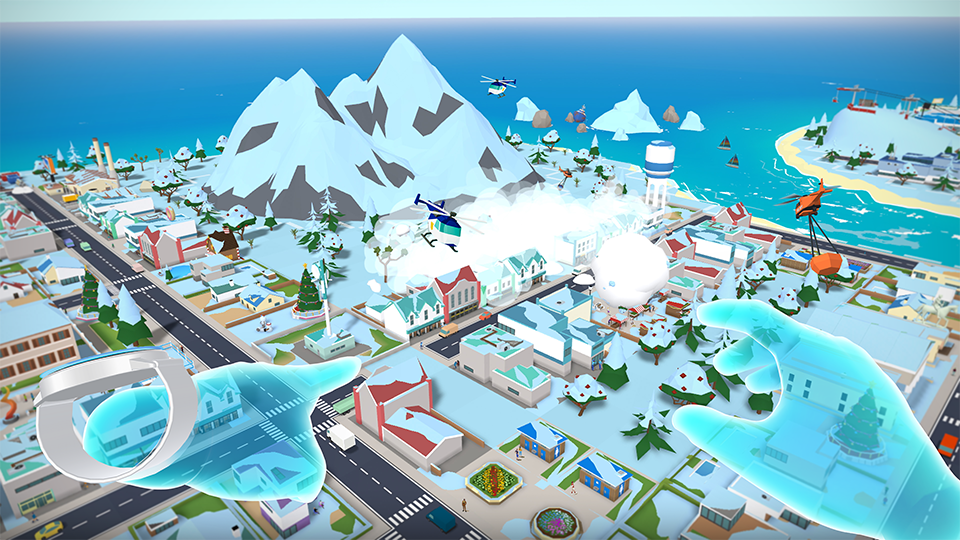 Little Cities advertises itself as an accessible and relaxing city builder and it is exactly that. There is no real pressure to build or crisis to handle, just expand as you like and if you screw up, there’s no real punishment, just demolish, place what you need to and keep expanding. It’s great for casual players who are just looking to dip their toe into the genre or are looking for a chill VR title. The included DLC does offer ways to make the game more challenging, but that will rely largely upon the player having the drive to build their own custom maps. There’s 8+ hours of campaign content here with sandbox mode effectively makes the game endless and while I wasn’t always having fun with the game, I was engaged enough to justify the full asking price for this casual and charming title.
Little Cities advertises itself as an accessible and relaxing city builder and it is exactly that. There is no real pressure to build or crisis to handle, just expand as you like and if you screw up, there’s no real punishment, just demolish, place what you need to and keep expanding. It’s great for casual players who are just looking to dip their toe into the genre or are looking for a chill VR title. The included DLC does offer ways to make the game more challenging, but that will rely largely upon the player having the drive to build their own custom maps. There’s 8+ hours of campaign content here with sandbox mode effectively makes the game endless and while I wasn’t always having fun with the game, I was engaged enough to justify the full asking price for this casual and charming title.
nDreams provided The VR Grid with a press copy for this title and, regardless of this review, we thank them for that!

